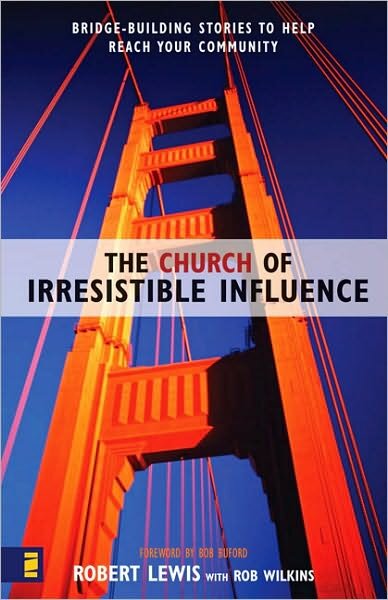Robert Lewis and Rob Wilkins, The Church of Irresistible Influence: Bridge-Building Stories to Help Reach Your Community. Zondervan, 2001.
LifeandLeadership.com Summary
This, alongside Sjogren’s Servant Evangelism Series and Rusaw-Swanson Externally Focused Series, are excellent models for social action among evangelical churches.
Irresistible Influence tells the story of the Fellowship Bible Church of Little Rock, Arkansas and their impact on the community through the attempt to be salt and light (Matthew 5:16), resulting in irresistible influence – i2. After experiencing dramatic increases in membership during the 1990s, and thus becoming a “successful” congregation, Lewis and his church became convicted they had become too preoccupied with themselves and separated from the needs of their community. Out of this connection, they sought to “build bridges” with the community through acts of service.
The book is divided into five sections:
Section One, “Spanning the Great Divide” uses the bridge-building analogy to discuss the significant disconnect between many churches and their communities as we enter the third millennium, which can only be overcome as the church presents “living proof” of the gospel it preaches through good works.
Section Two, “Designing the Structure” is more pragmatic, discussing how a church can better position itself to impact its community. This lays out an excellent church development model of small groups divided according to life seasons, that after a time of bonding and growing graduate to Common Cause groups that mobilize into i2 ministry.
Section Three, “Experiencing the Results” presents compelling stories from five years of practicing the irresistible influence principles. It tells of individuals, groups, and churches that have been “holy surprises,” “wounded healers,” or “urban entrepreneurs,” as they lived out the i2 principles. Readers could start with this section to be inspired and motivated.
Section Four, “Expanding the i2 Effort” discusses how to increase impact through partnerships with other churches and community agencies.
Section 5, “Anticipating the Future” describes the kind of changes churches must experience if they are to be a force for good in the postmodern era. Chapter 12 of this section provides a good refutation of evangelicals who might be wary of the i2 principle by labeling it as “social gospel.”
In the introduction, Lewis helps readers envision a situation similar to what theirs and other churches have experienced:
- The community in which you live being genuinely thankful for the church
- City leaders valuing your church’s friendship and participation in the community – even asking for it
- Neighborhoods around your church talking behind your back about “how good it is” to have your church in the area because of the tangible witness you’ve offered them of God’s love
- A large number of your church members actively engaged in, and passionate about, community service, and using their gifts and abilities in ways and at levels they never thought possible
- The community actually changing because of the impact of your church’s involvement
- Many in your city, formerly cynical and hostile toward Christianity, actually praising God for your church and the positive contributions your members have made in Jesus’ name
- The spiritual harvest that would naturally follow if this were true
This is an excellent blend of evangelism and social action, packaged into a workable scheme of spiritual/congregational development. It is not designed as a “cookie-cutter” process, although hundreds of churches continue to learn how to translate these principles in their own contexts through the annual Irresistible Influence Conferences. For evangelical churches that are series about mobilizing into ministries of social action, this is one of the most usable models available.
From the Publisher
A city set on a hill, inescapably visible. A lit lamp brilliantly illuminating the darkest room.
With compelling metaphors, Jesus described the church and its impact on the world. And indeed, filled with the Holy Spirit, the early church demonstrated a spiritual energy and depth that transformed the surrounding culture. Don’t let your church settle for less! Using bridges as a metaphor for “irresistible influence”—or i2, as he calls it—Robert Lewis shows how your church can become a strong, well-traveled link between heaven and earth in your community.
In this engaging and uplifting book, Lewis tells the stories and shares the experiences and lessons of Fellowship Bible Church to show:
- What it will take to reconnect your church with your community
- The how-to’s of “incarnational bridge building”
- True stories of i2 in action
- How to expand the i2 effort through new partnerships and adventures
- Requirements of the church in the 21st century
Discover how the power of incarnational bridge-building can impact your church and your community at the annual Church of Irresistible Influence conference.
About the Author
Dr. Robert Lewis is pastor of Fellowship Bible Church in Little Rock, Arkansas, founder of Men’s Fraternity, and chairman of the board of Fellowship Associates, a church consulting and leadership training organization. His previous books include “Rocking the Roles:, “Raising a Modern Day Knight”, and “Team Building in Marriage.” His annual Church of Irresistible Influence conference attracts hundreds of church leaders and key laypersons from around the world.
***For additional information on this resource, including reviews, click the bookstore links. Check the reference at page top or the links below for resource guides on related topics.***
See Other Resource Guides on Christian Social Ministry:
- Social Ministry, Introduction
- Theological and Philosophical Foundations of Social Ministry
- Spirituality for Ministry of Social Compassion and Justice
- Strategies For Christian Social Ministry
- Perspectives and Strategies For Social Ministry Among the Urban Poor, Urban Ministry
- Christian Perspectives on Political Theory and Church-State Relations
- Christian Perspectives on Economics and Public Policy
- Evangelism


